We are now in Saint Augustine, waiting in a wonderful marina while we have all our well worn cockpit canvas replaced. Since we have now completed our circumnavigation and have decided not to "do oceans" anymore, we have lots of offshore blue-water gear and spares that we won't need for the coastal cruising we have planned for the next few years. All of this is listed for sale on the Cruisers Forum, but we cannot seem to post photos there, so here they are:
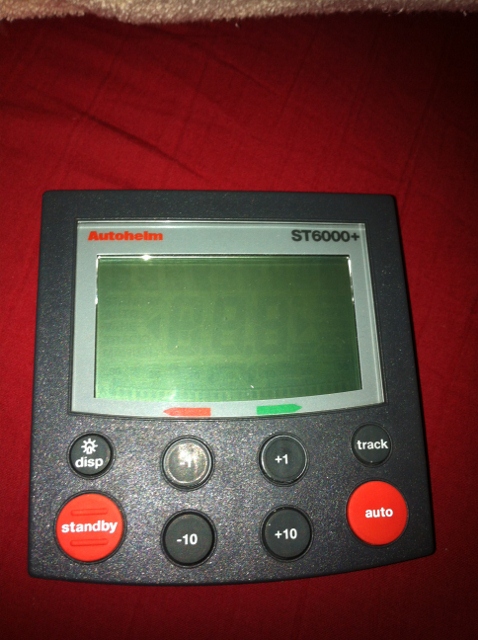 Autohelm ST-6000+ control head |  back of autopilot control head | 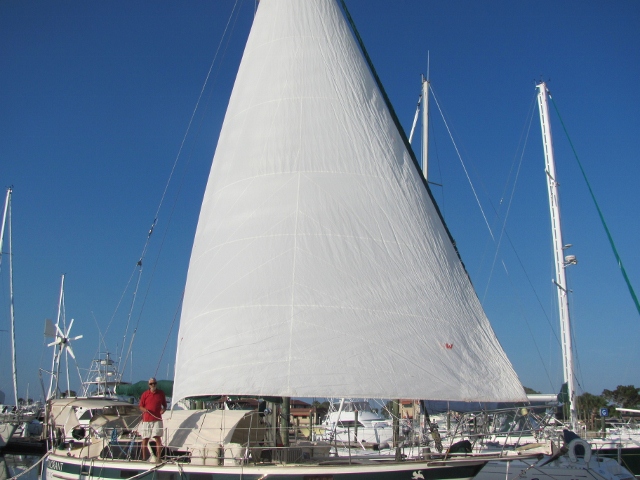 code zero | 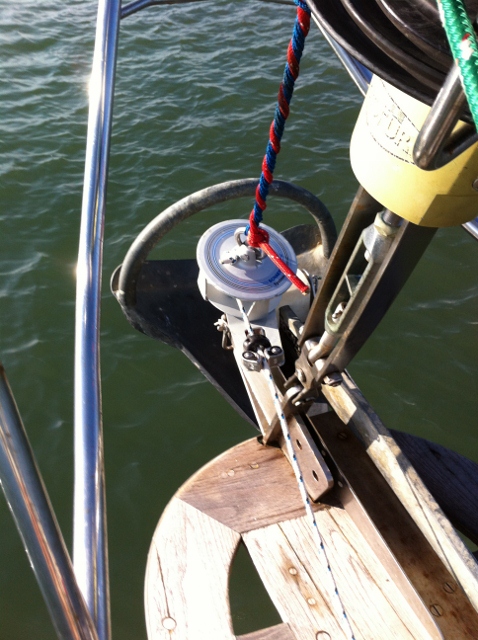 code zero furler | 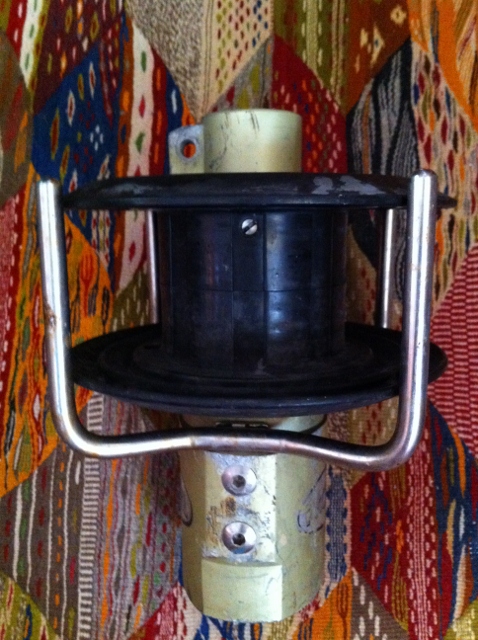 Profurl C42 drum | 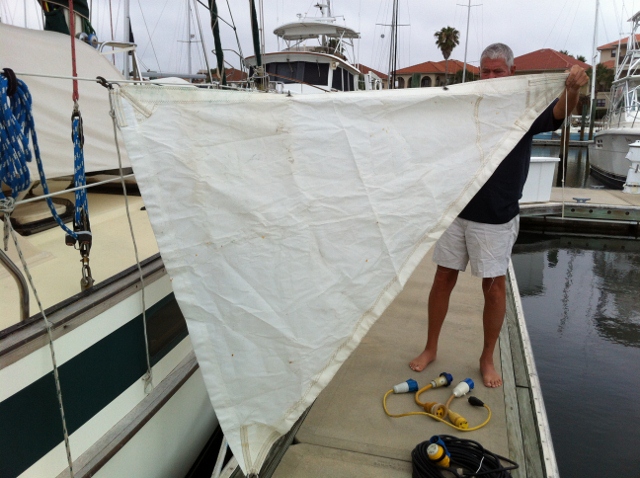 riding sail, to control sailing at anchor | 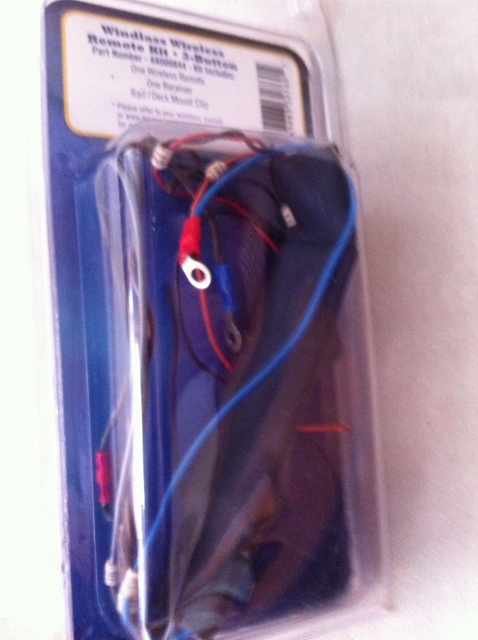 Lewmar Wireless Windlass control pn 68000844 | 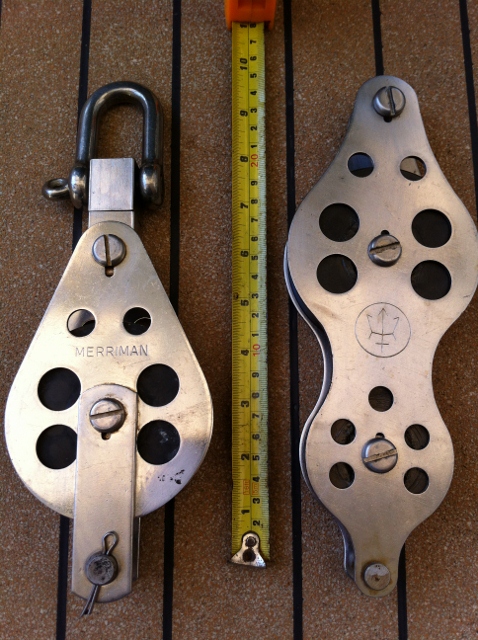 merriman single and double blocks | 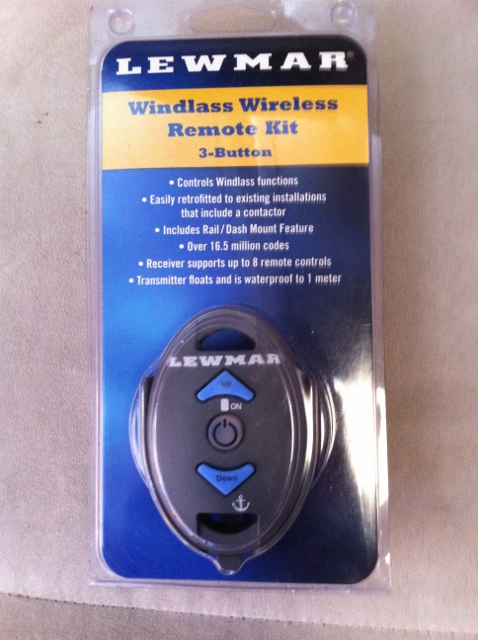 Lewmar wireless windlass transmitter | 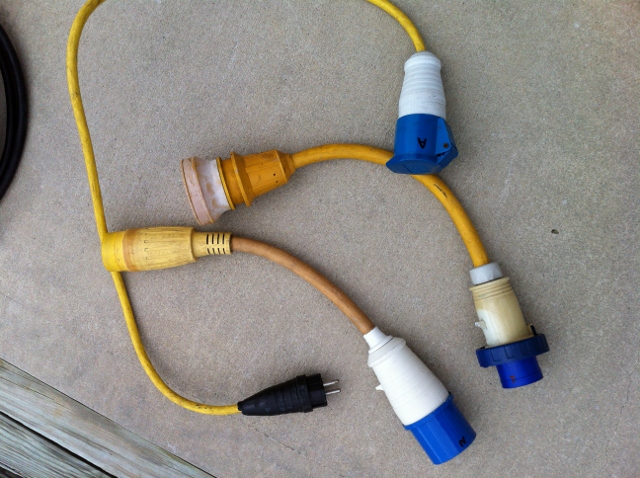 assorted power cables and adapters |  4JH3E exhaust mixer elbow | |
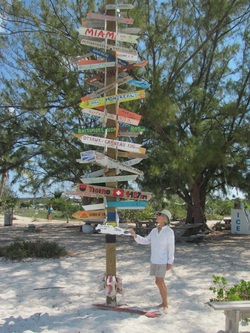 Now let's see. How far to ??? Yes, it has been over a month since the last entry, so obviously we have been having a great time and not looking too hard for internet connections. The Bahamas have very few free connections, since most of the boats there seem to go for the entire winter so they subscribe to monthly wifi service. We kind of enjoyed the break from constant connections.
After a week in the well-known cruiser destination of Georgetown, where winter cruisers organize activities almost everyday, culminating in a 2 week regatta at the end of the season, we moved on to Cat Island and then overnight up to the Abacos. We skipped this group on our way down in 1999, so we wanted to visit. The area is beautiful for sure, but with our draft--which is only 5 1/2 feet-- we had to be very careful and watch the bottom and the tides all the time. Average depth seems to be less than our keel, so we managed to hit bottom twice in our 2 weeks there. Oh well, at least there are no more barnacles on the bottom of the keel.

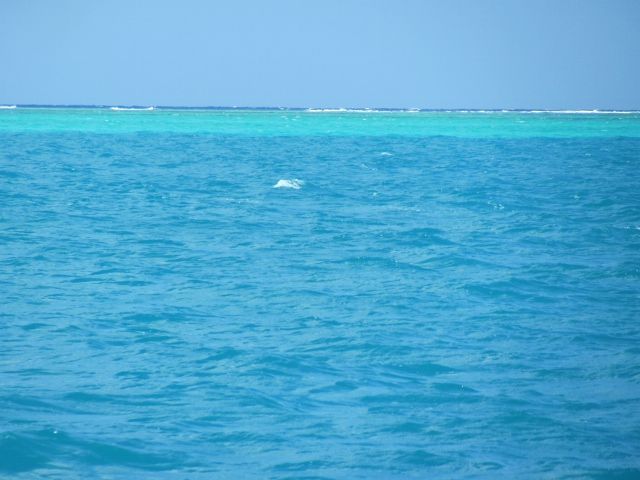 Unbelievable colors show depth 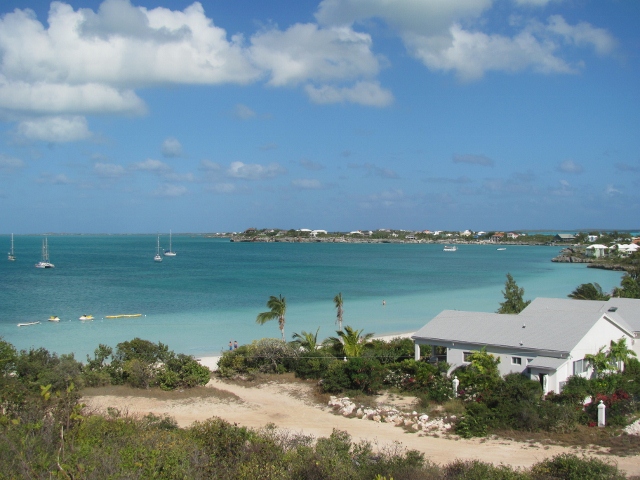 Sapodilla anchorage, Caicos  Historic Sapodilla Hill 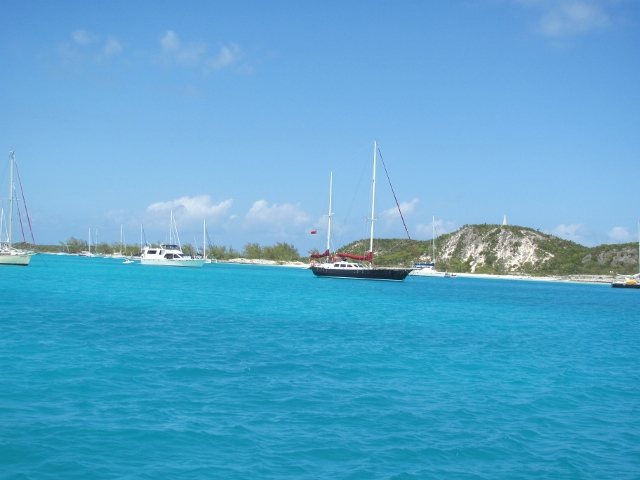 Monument anchorage, Georgetown | With a beautiful forecast we sailed out of Boqueron, Puerto Rico, on Saturday morning, March 17 heading north and west to the Turks and Caicos. It was one of the very best passages we have had in all our 15 years of cruising. Seas were regular and smooth, winds were constant from one direction, giving us a nice broad reach all the way, and there was no rain! Just before noon on Tuesday we made the turn into Sandbore Channel to get to Sapodilla anchorage in the Caicos. In the photo, the dark blue is the open sea, over 4000 feet deep. The lighter water is over the sand bore lining the channel, just 2 to 20 feet, and the medium water is the passage in. We are relearning how to read depths from the colors.
We were last in the Caicos in 1999, and the building boom has changed the whole place. Sapodilla used to be remote, and to get to town cruisers hitchhiked. Now, the bay is lined with beautiful homes, but the water and the people are still as nice as always. We hiked up the "hill" by the anchorage (probably 100 feet high) and saw grafitti from sailing ships passing here long ago.
After only 2 days in Caicos the weather looked good so we decided to make the 2 night passage to Georgetown in the Bahamas, where we are now. More fantastic colors in the water, an anchorage which can, and does, hold 100's of boats, and perhaps our last clearance into a foreign port with Cormorant. It is wonderful to be here after the famous Cruisers' Regata which finished March 11. Now the dinghy dock has plenty of room, the stores are well stocked, and we can even get room here at the internet place. We'll be heading up the islands toward the Abacos, and will probably update from there.
|
CRUISER INFO: Clearing in and out of the Turks and Caicos, staying no longer than 7 days, cost $100. Clearing in the Bahamas is $300 for up to 4 people, and it is good for 1 year with one re-entry, so boats wanting to cruise the eastern US and return within a year do not have to pay again. There is a transit clearance of $50, but you must be out in 7 days and if you want to then change to the cruising permit you have to pay the full $300, with no credit for the $50 you already paid.
 Dinghy exploring in Salinas We ended up spending a week in Salinas, getting groceries, installing the fridge, and just messing around. It has the reputation of being a good hurricane hole and this creek shows why.
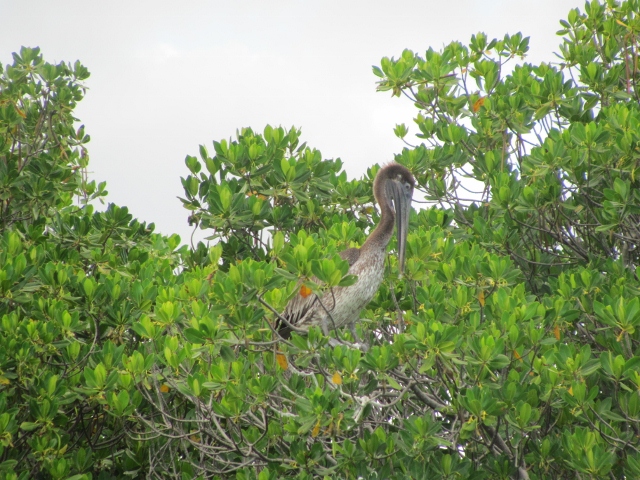
Lots of birds, but lots of stink too
|  The banks are lined with mangroves, and in a storm, boats go as far in as draft will allow and spider-web lines across the creek. One boat, visible under the clear water, didn't make it.
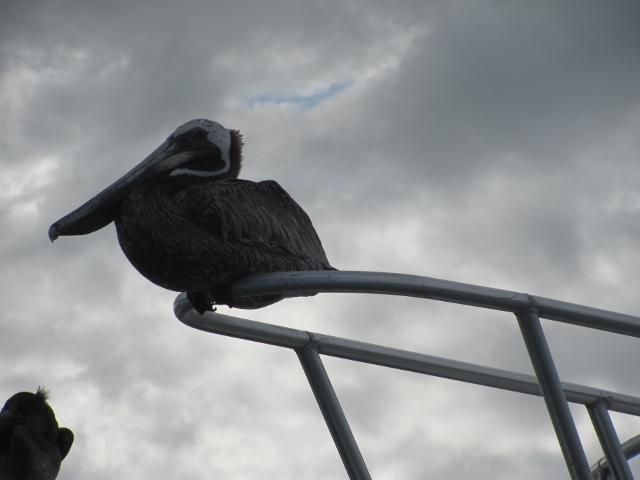
and some birds like to roost on boats
|
 "House" on the reef, Culebra Moving west from the US Virgin Islands, it is an easy day sail to Culebra, the closest of the so called Spanish Virgins. It is a whole different world, with no cruise ships, no charter boats, no beach discos, and plenty of nice friendly people. We felt like we were cruising again rather than being on vacation. As we entered the large sheltered harbor on Culebra, we passed the reef anchorage called Dakity. When we anchored here in 1999, navigation was "eyeball" to find the deeper water through the pass and into the anchorage behind the reef. Now, the DNR has put out free moorings (however we tried one and were not satisfied with the maintenance, so we slept much better on our own anchor) and red and green buoys mark the channel. One enterprising soul seems to have made a home, with 360 degree sea views, for a song.
After Culebra we sailed 10 miles to the south to Vieques. In 1999 it was closed to cruisers because the navy used it for test bombing and local people were protesting after a tragic accident. Since then, the navy base in Puerto Rico has been closed and Vieques is now mostly a park--very little development and all of that on the west end of the island. We spent 3 days in Ensenada Honda, and anchorage that is totally protected by mangroves and reefs and is so large it could hold well over 100 yachts. The most we saw was 3.
Then came one of those days which unfortunately happen when cruising. As we sailed 10 miles west to Esperanza, the strong winds ripped a meter long tear in our 14 year old headsail. That night, as we were rolling miserably in the anchorage, our refrigerator evaporator sprung a fatal leak. Harry repaired it 2 years ago, but the metal is so thin to improve efficiency that, on a constantly moving boat, its useful life is about 5 years. We put this one in 7 years ago in New Zealand, so it was time. Our despair was short however. The next day we sailed to Salinas, on the south coast of Puerto Rico and found a very large, beautiful protected anchorage with friendly, helpful people ashore. We took the sail in for repair, got in back in only 2 hours, and the total cost was $45. We ordered the new evaporator which had to be shipped from South Carolina, and 30 hours later we got the call that it was in the store and when were we coming to pick it up! Now Harry has been working all day to install it, and right now the lid is going back on the freezer. We will enjoy our sundowner time today for sure.
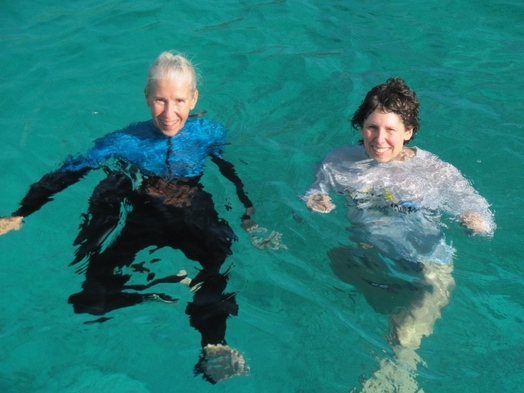 Happy snorkelers! Jane and her sister Mary, as you can see here, had a wonderful week of snorkeling and swimming at every opportunity in the US and British Virgin Islands. Mary was able to stay 8 days, so we could go more places and hit the snorkeling highlights. The very best was the Indians in the BVI, followed by Leinster Bay on St. John. We swam with loggerhead and hawksbill turtles, saw rays from the boat and while swimming, and even had to get the underwater guide to corals and fishes out to identify all the things we found. Since Mary is having a partial knee replacement in a week, walking was out but swimming was fantastic. No pain with no gravity to push those bones together. Plenty of rum and tonic, good food, and good books to read in the afternoon "siesta" time made the time pass all too quickly.
Now it is time to say good-bye to the Virgin Islands and begin our trip to the west and the north. Tomorrow we will sail to Culebra, one of the "Spanish Virgin Islands" and part of Puerto Rico. From there we plan to go to Vieques and then along the south shore of Puerto Rico before jumping off for the Bahamas. The next update will be from new cruising grounds, since we want to go to some of the places we missed on the way down in 1999.
 Mary Ellen at the helm Yes, this is really Mary Ellen, at the helm of CORMORANT. Back in 1999 she and John came for a visit, and we took them on an overnight crossing of the Gulf Stream from Florida to the Bahamas. What a poor decision that was, because they were both sick and we thought they would never return to the boat! Well, as we said in the last few posts, the Virgins are perfect for fun sailing for almost everyone.
We spent 5 packed days exploring St. John with Harry's "little sister" Mary Ellen. At Leinster Bay, we hiked the Johnny Horn trail, up and over the top of the island to Coral Bay, where we had lunch at the famous "Skinny Legs" bar. We hiked an extra mile on the way back, taking the Brown Bay trail and avoiding the 1/2 mile of straight up on the Johnny Horn. Age has helped us make some better decisions, we hope!
Besides hiking, we had some fantastic snorkeling. In my memories from our last visit in 1999, the corals were mostly dead and although there were lots of turtles, the reefs were colorless and fish were few. Last week, we saw a beautiful spotted eagle ray, Mary Ellen got to swim with a turtle, and the reefs were colorful and full of all kinds of odd and brightly colored fish. Although we hate the bumping of the mooring balls on our hull, it is evident that preserving the seabed from anchor damage does help restore fish and coral.
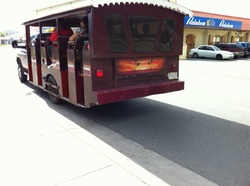 The $1, $2 Safari Bus This past week has been one of relaxing in beautiful Brewers Bay, doing maintenance chores, and the spending a wonderful day on an island tour with our friends Andy and Dianne. It was great to have friends with a car to drive us places we could not get to by ourselves, but we would have to say that the transportation highlight of the week was the day we spent riding all over (to find Home Depot and Budget Marine of course) on the safari buses. Basically a truck with open air bench seats in the back, these "buses" travel a set route along the island. If you go halfway along the island, it is $1. If you go over half, it is $2. You just pay the driver when you get out. With steep, winding roads up and around the hills, the views are magnificent and the price is certainly right. It doesn't take much to make cruisers happy.
This afternoon, Jane's sister Mary is coming to visit for a week. We have an excellent weather forecast--as always here--so we are off to find some anchorages and snorkel spots we haven't yet discovered.
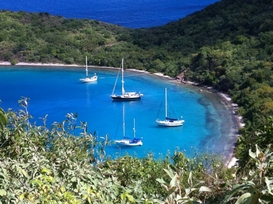 Anchored at Benures Bay, Norman Island This is detailed information for our cruising friends who might be thinking of coming to the BVI. For the "newsy" post, scroll down to the next one and skip this.
Clearing in is very easy, but the easiest spots are at Soper's Hole West End, Tortola or at Jost Van Dyke. Both of those harbors have mooring balls you can pick up for several hours without charge, so it is easy to go in, clear, and then move on. At West End, there is a wonderful grocery store called the Harbour Market which is at Soper's Hole Marina. The Customs Office is across the harbor at the ferry dock. For us, it cost $19 to check in and we think that allows you up to 30 days. To check out we had to pay $0.75. (yes, that says 75 cents). If you stay less than 4 days you can check in and out at one time, but there is far too much to see and do in 4 days.
If you want to anchor rather than take a mooring, it is possible. The locals think it is too deep to anchor most places, but they consider anything over 20 feet as too deep. The places we actually anchored are as follows: (1) Benures Bay on Norman Island. The wind swirls around so we and most of the other boats anchored in good holding sand and then stern tied to a tree. About in the middle of the curve of the Bay there is a trail leading to an overgrown road. It is about a 40 minute walk with great views over the hill and down into The Bight, which is a famous anchorage full of moorings. There is a beach bar with wifi. The room left for anchoring in the bight is right at the front of the mooring field to the right of the bar (looking from your boat as you come in). There is room for 4 or 5 boats to anchor, but be ready for noise. (2) Marina Cay, to the northeast of Tortola. This is a beautiful place with a restaurant on a little island. There are lots of moorings but we anchored just at the back of the mooring field in about 30 feet of water. Excellent holding in overnight winds of 20-25. At those winds, there was some swell coming over the reef. (3) Vixen Point, Prickly Pear Island, Virgin Gorda. This was the prettiest of all. There is a small mooring field off of the SandBox restaurant and beach, but just to the north of the moorings is lots of room to anchor in 15-25 feet on good holding sand. Here we had gusts up to 38 knots with no problems and flat seas. The view in the evening across the sound, with the sky streaked with color and late boats sailing into the harbor, was magical. (4) Inside Road Town harbor, right past the cruise ships and through the entrance leading to Village Cay Marina and the Moorings Marina, there is an anchoring area which can hold at least 6-8 yachts. The bottom is thick, gooey, stinky mud so a chain wash down is nice. It is totally flat and calm in there, and we used our dinghy to get to the best chandlery in the BVI, the Golden Hind, and then an short walk to a wonderful grocery store, called RiteWay. Go to the big one past Wickham's Cay II. By taking the dinghy to Village Cay Marina it is an easy walk to the ferry dock to clear in or out.
Other places we saw or have been told are good to anchor if you don't want to take a mooring: (1) Drakes's Anchorage at Virgin Gorda. We had a good view of the boats there while we were at Vixen Point, and it looked very good. (2) Deadman's Bay on Peter Island. Look for a sandy spot in the eel grass. There is supposed to be good hiking ashore. (3) on Jost Van Dyke, right up at the east end, there are some small cays and reefs. Go with good light and it is supposed to be easy to find a nice spot.
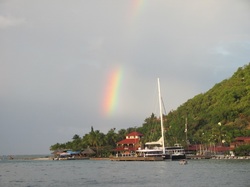 Bitter End Yacht Club, Virgin Gorda We have just finished a week in the British Virgin Islands, and they are as beautiful as we remembered—but maybe even more full of boats. What can you expect, really? It is easy to get to the BVI from the US and Canada, they are warm when most of North America is cold, the winds blow reliably from the east in the winter, and with all the islands, the rough water from the open sea is blocked. We have never seen so many charter boats in one place anywhere else in the world. When we were sailing or anchored, they seemed to be everywhere, but when we went into the capital, Road Town on Tortola, to check out, there was an entire marina completely full of charter boats which were NOT out on charter. We can't imagine what it would be like if they were all rented, but the economy must be having a real impact on these businesses. In a very smart move, the government and individual businesses and marinas have put mooring balls in almost every nice anchorage area. One of the big problems with charterers has always been that they usually don't have good anchoring skills (we are being nice—most anchor with far too little scope, don't set the anchor, or anchor too close to other boats) so we full time cruisers try to stay clear. With the moorings, all they have to do is pick up a line floating from a ball, pass a rope through it and remember to tie both ends of the rope to their boat. At $25-30 per night, this is an expensive option for a cruiser, but for someone on a charter vacation it is peace of mind. The very best part of the BVI is that it is illegal to use a jet ski, AND it is illegal to smoke anywhere at all unless it is marked smoking! Our idea of good benevolent dictatorship.
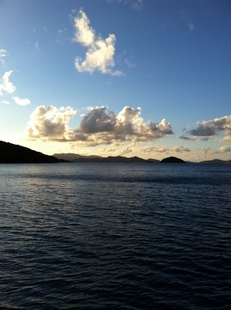 Evening view from the cockpit In our 10 nights in the BVI, we managed to find wonderful, free, spots to anchor for 8 of them. For one of the paid nights we went to a marina to do the wash in a machine (heaven!). For the other, we took a spot at the Bitter End Yacht Club because we wanted to go back to a place we had loved. As you see in the photo, the place is wonderful, but the mooring ball keep beating against our hull all night so we couldn't sleep, and some heavy drinkers playing loud country music on the big charter cat next door kept going late. The next morning we went about 2 miles away to a much prettier place, where we could relax at anchor. We stayed 3 days.
Monday we arrived back in Saint John, USVI, at Caneel Bay, to fix the leaks in our dinghy and clear off our spare berth (normally the "garage") for Mary Ellen who will arrive Wednesday. We'll do some relaxing, some hiking, and some snorkeling for sure.
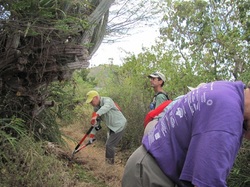 Jeff (center) of Friends of the VINP We knew from our friends Ken and Janet on Aquilla, who volunteered multiple times in the park at the end of their circumnavigation, that working in the park clearing sites and trails would be something we would like. Ken obviously did, because we were told by the coordinator, Jeff, that Ken holds the record at 28 times in one year! We have only done 2 days so far, but we both have beautiful green park volunteer T-shirts to show for it. It is something everyone can do and it is a great way to see more of the park and to give something back at the same time. Hot, sweaty work, but fun.
All we had to do was take our dinghy to shore and Jeff came by the Maho Bay campground beach at 8:30 with a van and other volunteers. The first day we went to the SW of Coral Bay, where we cleared two trails. Crossing the beach we saw several donkeys lounging in the shade. They are feral and a big problem for the park, but controlling the population is not easy. The park neuters all the males inside the park, but since 1/3 of the island is outside the park, it is not totally effective. The second trail we did passed along a salt pond to Drunk Bay. It is a wild and rocky place facing windward, but among the black stones on the shore are pieces of white coral and scattered coconut husks. Visitors and locals pick up interesting shapes and make figures on the rocks. We saw Elvis, Merry Christmas, and hundreds of others. On our second work day, we cleared the battery at the fort where the slave rebellion on St. John began. When we arrived, we could not see the walls or any cannons at all. When we left, the walls were exposed and 5 cannons lay out in the sun.
On Friday, we decided to sail the 4.5 miles to the British Virgin Islands, where we plan to stay for about a week. Clearing in was easy, because they have mooring balls everywhere and they are free unless you stay overnight. So we picked up a ball at West End, cleared customs, shopped at the best grocery store we've found in either the US or British VI, and by mid-afternoon were at anchor in Benures Bay and having a swim. No wonder this is charterers' paradise. More to come about the British VI
|